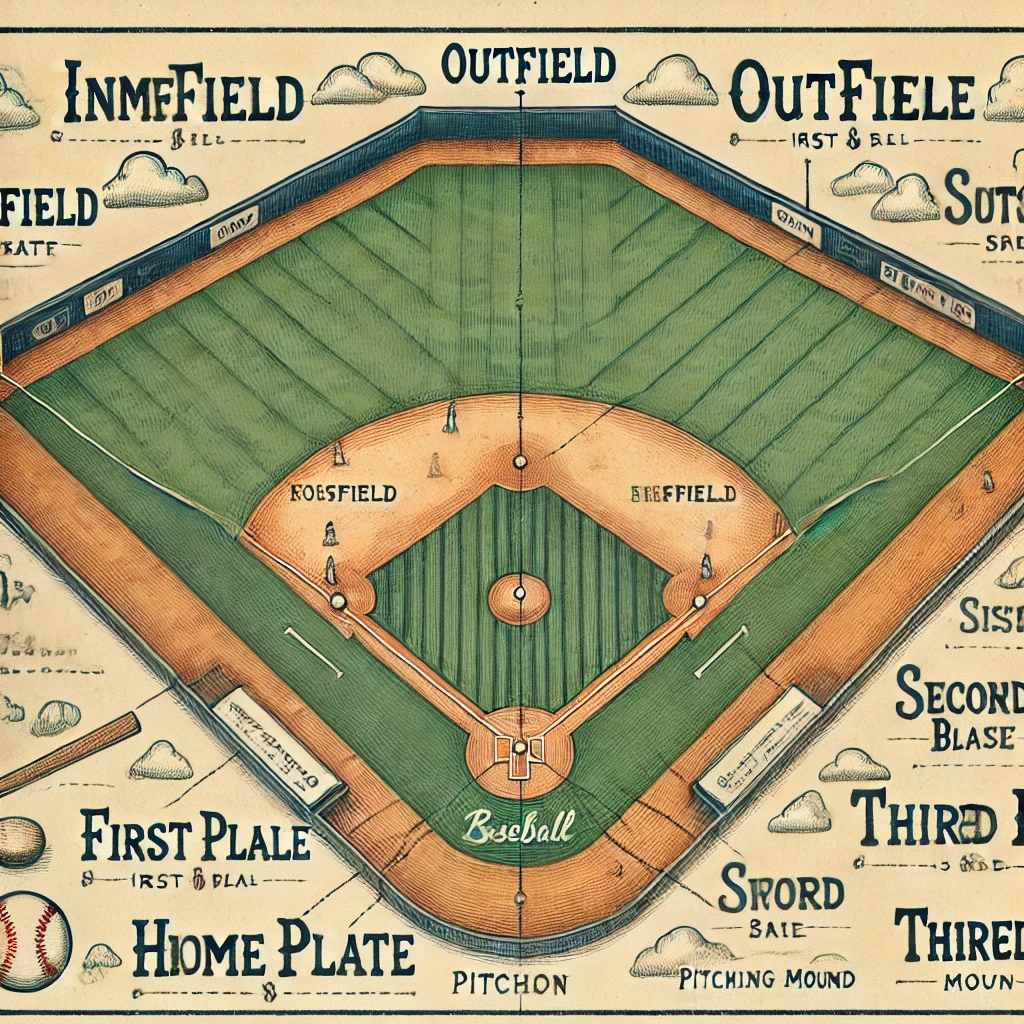Baseball is a sport with a rich history dating back to 1744. It is predominantly popular in North America, Canada, and Japan, with the World Series of Baseball being the pinnacle of the sport.
Objective of the BaseBall
The objective of baseball is simple: score more runs than your opponent by hitting the ball thrown at you and running around the four bases on the field.
Players & Equipment
- Teams: A game is played between two teams, each consisting of 9 players.
- Game Duration: The game lasts for 9 innings, with each team alternating between batting and fielding in each inning.
- Scoring: The scores at the end of the innings are added to a cumulative score, and the team with the most points wins.
- Outs: Each team has three outs per inning before they swap roles.
- Field Sections: The field is divided into two sections: infield and outfield, with a diamond shape separating the two.
Field
- Bases: The infield consists of four bases: home plate, first base, second base, and third base.
- Pitching Mound: Located in the center of the infield, where the pitcher stands and throws the ball.
- Home Plate: The batter stands here and must touch all bases before scoring a run.
Scoring
- Hitting and Running: To score, a batter must hit the ball into the designated fielding area and make it around all four bases before the fielding team collects the ball and throws it to the base the batter is running to.
- Home Run: A player can score a mandatory point if they hit a home run, which usually means the ball has left the playing area.
- Multiple Points: Players can score multiple points from one hit if more than one player is already on base.
Winning the Game
- Outscoring: To win a game, a team must outscore their opposition through the 9 innings played.
- Final Score: The team with the most points after 9 innings is deemed the winner.
- Tiebreaker: In the event of a tie, extra innings are played until a winner is concluded.
Rules of Baseball
- Innings: Games last for 9 innings, with both teams getting to bat once per inning.
- Tiebreaker: If the game is a tie after 9 innings, an extra inning will be added until a winner is found.
- Batting Order: Once a batting order is picked, it cannot be changed throughout the game.
- Substitutes: Substitutes are permitted but must bat in the order of the previous player whom they replaced.
- Running to First Base: A batter must make an effort to at least get to first base after hitting the ball from the pitcher.
- Touching Bases: Each base must be touched with some part of the batter’s body when running past.
- Strikes: A batter gets up to three strikes before getting out. A strike is deemed when a batter swings for a ball and misses it or leaves the ball within the strike zone.
- Walks: If four balls miss the strike zone and the batter does not swing their bat, they can walk to first base.
- Dismissals: Players can be dismissed by strike out, force out, fly out, or tag outs.
Additional Information
- Positions: Each player on the field has a specific position such as pitcher, catcher, first baseman, second baseman, shortstop, third baseman, and outfielder (left fielder, center fielder, right fielder).
- Pitch Types: Pitchers use various types of pitches to confuse batters, including fastballs, curveballs, sliders, and changeups.
- Fielding Strategy: Fielding teams use different strategies based on the batter and game situation, including shifts and positioning.
- Baserunning: Players on base must decide when to run based on the hit, often taking risks to advance to the next base.
Common Terms in Baseball
| Term | Definition |
|---|---|
| Double Play | A defensive play that results in two outs. |
| Triple Play | A rare defensive play that results in three outs. |
| Stealing a Base | When a runner advances to the next base while the pitcher is delivering the ball to home plate. |
| Bunt | A batting technique where the batter lightly taps the ball to advance runners. |
| Grand Slam | A home run hit with all three bases occupied, scoring four runs. |
Summary
Baseball, a sport with a rich history dating back to 1744, is popular in North America, Canada, and Japan. The main objective is to score more runs than the opponent by hitting the ball and running around four bases.
A game consists of two teams, each with 9 players. The game lasts for 9 innings, where teams alternate between batting and fielding. The team with the most points at the end of the innings wins, and in case of a tie, extra innings are played.
The field is divided into the infield and outfield, with bases at each corner of the infield. The pitcher throws the ball from the mound in the center, and the batter tries to hit it and run the bases to score.
Key rules include:
- Each team has three outs per inning.
- Batting orders must remain the same throughout the game.
- A player must reach first base after hitting the ball.
- A batter gets up to three strikes before being out.
- A walk is granted if four balls miss the strike zone without a swing.
Scoring involves hitting the ball and running the bases or hitting a home run. Players can be dismissed through strikeouts, force outs, fly outs, or tag outs.
Additional aspects cover player positions, pitch types, and fielding strategies. Common terms include double play, triple play, stealing a base, bunt, and grand slam.






